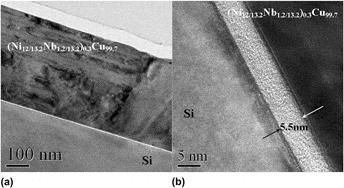Article contents
Barrierless Cu–Ni–Nb thin films on silicon with high thermal stability and low electrical resistivity
Published online by Cambridge University Press: 20 December 2013
Abstract

In this paper, we demonstrate a thin film Cu–Ni–Nb alloy deposited directly on silicon, without a designated barrier, showing very high thermal stability at a temperature up to 700 °C for 1 h. Thin [Nb–Ni12]Cux films were sputter deposited and annealed, and their material and electrical properties were studied. The results can be explained by the “cluster-plus-glue atom” model for stable solid solutions, where [Nb–Ni12] cuboctahedral clusters are embedded in a Cu matrix. In this model, the clusters are congruent with the Cu minimizing atomic interactions allowing a good stability. The properties of the films were found to be affected by the Ni/Nb ratios. Especially, the (Nb1.2/13.2Ni12/13.2)0.3Cu99.7 film annealed at 500 °C for 1 h had the lowest electrical resistivity of about 2.7 μΩ cm. And even after 40 h annealing at 500 °C, it maintained a low resistivity of about 2.8 μΩ cm, demonstrating extremely high stabilities against silicide formation.
Keywords
Information
- Type
- Articles
- Information
- Copyright
- Copyright © Materials Research Society 2013
References
REFERENCES
A correction has been issued for this article:
- 9
- Cited by
Linked content
Please note a has been issued for this article.

